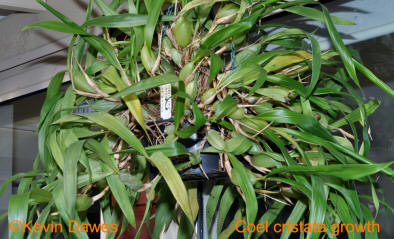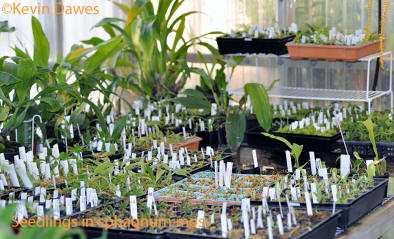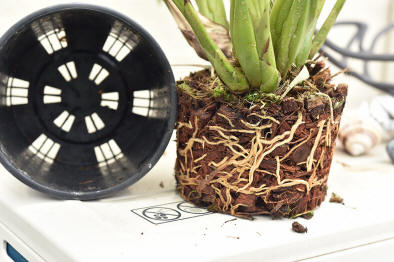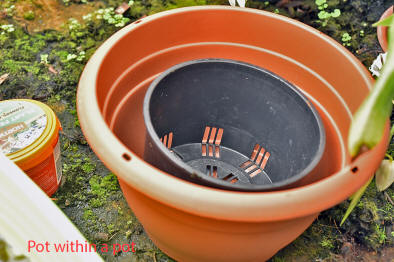WHEN to repot is one of the most worrying questions for many people. Don't think twice about tipping your plant out of its pot and having a look. When you replace it in its pot it will carry on as if nothing happened - even if you spill a bit of its potting mixture. If the soil looks rotten, smells bad or there are lots of dead roots then it needs repotting. If the roots look alive and healthy (most of them will be basically a white to light brown colour) it is amazing how crowded they can be and still support a really healthy plant. If they look healthy and are growing (see images above) you don't need to worry about repotting.
Some orchids e.g. the very healthy Coelogyne cristata (image above) can continue in this stage for years, simply stacking more psuedobulbs on top of each other and over-flowing the cramped roots around the edge of the pot. Surprisingly, it will flower spectacularly in this condition. When your orchid gets to this stage and you really develop a passion to repot it you can be absolutely feral. You will need great strength to rip it out and chop it into a few big chunks and repot (some brave growers really use an axe !)
Some Coelogynes would feel imprisoned if their roots were locked in a pot. They spread like a viral weed, the metre long thick roots searching for new sites to colonise. They will even do a 'cuckoo' trick and tap into a neighbour's pot. Of course, there is a full range of root behaviours in between. The moral is that adventurous roots are often normal and not a sign to repot. Note the open pot and the coarse open potting mix.
Small seedlings need special nursery care and need to be repotted every couple of months or so. The seedlings in the image to the right are potted into sphagnum moss. Because it is a living plant itself it needs very careful management to keep it alive too. It can easily become waterlogged and go sour and it can easily dry out and become difficult to get wet again. In the right background of the image you can see green healthy moss growing beautifully with the seedling in it. This is what you are aiming for. Keep the moss extremely loose and well misted.
The easiest and laziest way to repot is to simply place the plant (pot and all) into a bigger pot and fill the gap between the two pots with new media (soil). The plant will be perfectly happy and grow its roots into the new space. The downside is that it is a bit more difficult to divide the plant one day and how many pots within a pot can you do ?
A more virtuous technique is to remove the pot before following exactly the same procedure as above. However, cut away any dead roots and discard any soggy soil you see. If your pot is really rotten you may end up with no roots left at all and you may need to to use a couple of stakes (or a few plant label holders around the edge of the pot and connect these with wire) to hold the plant upright and absolutely secure. The new roots that will grow have extremely delicate tissue on their tips and must not be allowed to rub against soil particles, etc. as a result of the plant moving about. Think of this new tissue like that of a human open wound growing new tissue – it wouldn’t like to be rubbed or bumped!
Try not to compact the new media by pressing it hard into the pot! Think of the loose accumulation of debris in the fork of a tree or along a tree limb. It needs to have lots of air and drainage. If the plant needs stability use stakes or wire, etc. until it grows supporting roots.
Don't forget to tip your plant out of its pot especially if the psuedobulbs are scrivelled or if it's not doing well and have a look. Normally if it's still growing then it doesn't need repotting. Note the good drainage in the pot and the healthy white roots in this plant. It can wait longer before repotting. Simply put it back in its pot and give it a drink. It won't hate you !
| < Media | Watering > |





